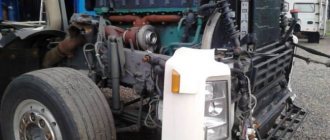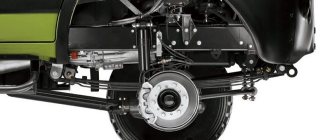In the model range of every automaker there is a flagship with the most powerful engine. The Volvo FH16 can be considered the flagship model not only of VolvoTrucks, but of the entire European truck industry: it is the most powerful production truck on the continent. Having created the Volvo FH16-750, it overtook its closest competitor, Scania, by 30 horsepower. Of course, such a powerful (750 hp) and expensive truck cannot be widespread: carriers do not need such powerful equipment. Unless we are talking about transporting some particularly large construction equipment and indivisible cargo. Ordinary trucks for such a tractor will be just toys. Therefore, in mass production, Volvo FH16 engines have not so monumental engines. Details below.
Currently, the Volvo FH16 is presented on the market in various modifications. These are diesel engines of varying power - from 400 to 750 hp, chassis options - 2 or 3 axles. And the “highlight” of the new generation “Volvo FH16” is the independent front suspension on double wishbones IFS (it will be discussed below, in the corresponding section of the review). However, there are also traditional options, with a transverse beam, which, in turn, are divided into suspensions made on two- or three-leaf springs, as well as on semi-elliptical or pneumatic cylinders.
For transportation on general roads, at normal speeds, modifications with a 4x2 wheel arrangement are usually used as part of a road train. Volvo FH16 truck tractors with a 6x4 wheel arrangement are designed for transportation of large-sized cargo by road trains with a total weight of up to 85 tons. It is possible to order four-axle trucks of this brand to work with even heavier semi-trailers. In this modification, the total weight of the road train can be increased to 100-120 tons.
Reviews of Volvo FH
Vlad writes:
The most crap machine I've ever worked on, from the seat to the sleeping bag, to the back after the first night.
Karel writes:
Colleagues, I welcome everyone.
Please tell me whether it’s worth bothering with or not: I took a VOLVO FH12 1996. 380 l. With. I want to add up to 420 hp. at the service station. You will probably have to change the injector pump for 420 hp. Which way to go?
Alexander writes:
Guys. I can say one bad thing about Volvo. A very uncomfortable cabin for two. Sleeping places are bad. Especially mattresses. The top springs are actually creeping into the sides. Please, Volvo's - look at the sleeping places of Dafa and Mercedes. At least we got enough sleep in them after a work shift. But in a Volvo it’s just a pain to sleep.
Good luck everyone. I've been working for Volvo for 10 years. And sleeping places are a problem for Volvo!
Andrey writes:
Tell me, did you turn off the urea? Will this affect fuel consumption? They say that the Nox sensor will reduce power - thereby increasing fuel consumption. Do I need to remove the catalyst after switching off? Or drive with urea until it breaks?
Sergey writes:
I am working on a 2022 Volvo FH 460 – very pleased!
The cabin is warm, the autonomous system heats perfectly (considering that it is 2 kW).
It holds the road and the handling is excellent.
The only downside is that maintenance is expensive and the batteries run out quickly...
Roman writes:
I work on a Volvo FH 13 2014. – 460 horsepower, Euro-6, automatic transmission. The cabin is high - Globetrotter. The odometer now shows almost 500,000 km.
The engine pulls great – both on a straight road and on hills. It picks up speed quickly, especially for a truck. Fuel consumption is good. On average it comes out to 27 liters per 100 km. There are no complaints about the machine - it works properly. But if desired, transmissions can also be switched on manually.
I like the optics - it shines great in the dark. There are bi-xenon headlights at the front and LED lights at the rear. The fog lights are also good. By the way, they can highlight turns, but only at speeds up to 40 km/h.
There are two folding steps above the bumper at the front. I stand on them when I clean the glass.
The cabin is spacious and roomy. The design is, I would say, futuristic. But personally I liked it. The materials are high quality and pleasant to the touch. The leather is still like new. On top there are large drawers and shelves for things. Everything is done wisely, for the people. And in general the ergonomics are wonderful. There are two sleeping bags inside - both are quite comfortable. Under the bottom there is a pull-out refrigerator. There is enough space in it for the eyes.
All necessary information is displayed on the on-board computer. I am especially pleased that there is a Russian language. I listen to music from a flash drive. The sound quality is beyond praise. The speakers are so good that no subwoofer is needed.
Well, the last thing is the appearance. The new FH looks amazing. The designers did a great job.
Dmitry writes:
I have owned a Volvo FH12 95 since 2000. When I bought it, the odometer showed 420,000 km. In 17 years I have driven 1,650,000 (that is, the total mileage is 2,070,000 km).
Initially, the car had three axles - 6x2. After riding with the sloth for 2 years, I realized that it was useless (extra ballast), and decided to remove it. The result was a tractor with a 4x2 wheel arrangement.
The suspension is completely pneumatic - both front and rear. The cabin is also outdoors. In general, it’s comfortable to drive on any road.
The best power supply of a Volvo tractor
The best power-to-power ratio of a truck is a term in which a road train, moving on flat terrain and at normal speed in the highest gear, easily maintains the engine crankshaft speed in a gentle range, maintaining a reserve of power in order to calmly overcome climbs and gusts of wind, as well as places with increased resistance to wheel movement.
Studies show that a truck with goods moving in the highest gear must overcome an incline of 1.2-1.5%. Optimal energy efficiency is the quality of a car at which it travels at least 80% of the way on flat terrain in top gear. The tractor engine must maintain 1400-1500 rpm.
If a truck has less power, then it needs frequent gear changes, which entails a loss of speed, and therefore increases the specific fuel consumption of a diesel engine. In addition, excessive fuel consumption is also affected by incorrect choice of gear shift timing.
Auto company specialists will help their clients in forming and updating their vehicle fleet. But fuel savings will become possible with the correct selection of road trains in daily road transportation. In this case, certain rules also apply.
Large trucking companies can purchase an MVC program. If the road train travels in suburban or international traffic, then engine power has little effect on the specific fuel consumption of a diesel engine. When passing through rough areas, cars with a powerful engine are more profitable. In urban areas, greater power entails a significant increase in consumed diesel fuel.
Automotive science says that the specific fuel consumption of a diesel engine is, on the one hand, influenced by the quality of automotive mechanisms (engine, wheels, gearbox), and on the other, by the resistance that impedes the movement of the vehicle. The latter factors include air resistance, vehicle inertia, and wheel rolling resistance.
Air resistance is considered one of the most important factors that affect fuel consumption if the car is moving on a flat and smooth road section. The higher the speed of the car, the greater the resistance. A road train with perfect aerodynamic properties must “pass” through the air flow with minimal air turbulence. The smaller the frontal area of the tractor, the lower its fuel consumption.
Modern means of effectively reducing aerodynamic drag are spoilers (air deflectors), which are installed on the top and side of the car cabin. Their use makes it possible to reduce the specific fuel consumption of a diesel engine, because even a 40-ton vehicle can save up to 10% of diesel. But a good result can only be achieved with the correct installation of the spoiler: it is necessary to take into account the distance from the car cabin to the trailer and the height of the air deflector, which smoothes out the difference in height between the cabin and the semi-trailer.
Rolling resistance occurs between the road surface and the car tire. As it decreases, fuel economy increases. In order for diesel fuel consumption to tend to decrease, it is necessary that the number of tires be fewer and their sizes larger.
In addition, the availability of tubeless tires with a longer service life and lower rolling resistance helps reduce the specific fuel consumption of a diesel engine. The pattern on the tire tread also plays a huge role in this. Fuel consumption will be higher if the car has a rough tread pattern, many wheels (especially small ones) and a very low tire profile. It must be said that new, not yet worn out tires have more rolling resistance than those that have already been used.
Monitoring fuel consumption also includes monitoring the tachometer. The driver must stay in the green sector and ignore the sound of the engine. In addition, he must remember that the car’s power lies in low engine speeds.
Another important component of solving this issue is monitoring tire pressure. If the pressure decreases, then in addition to increasing rolling resistance, another problem may arise: the service life of the tires sharply decreases. Practical studies have shown that when the tire pressure is 80% of the norm, their reserve will be equal to the same number. In addition to all of the above, overload and high speed lead to a reduction in the life of tires.
Fuel consumption fsh 12 420 Volvo, repair instructions, video. Volvo fh engines
| Volvo FH chassis specifications | Volvo Trucks FH series models are designed for operation both as single vehicles with a gross weight from 18 to 32 tons, and as part of long-haul road trains with a gross weight of up to 60 tons. The braking system on most Volvo FH13s consists of EBS electronically controlled disc brakes, however there are also older trucks that are equipped with drum brakes. |
| The results of a long-term test of the Volvo FH with the I-Save system have become known. How much does it really allow you to save: Auto news from AUTO-Consulting - Volvo For such special equipment, it is necessary to use two fuel consumption standards for vehicle mileage per 100 km and for operation of a refrigeration unit for 1 hour or for 1 vehicle. The tractor-trailer features adaptive cruise control with an advanced forward collision warning system with emergency braking, combined with lane-keeping and lane-change assist systems. |
Tractor unit details • I am working on a 2022 Volvo FH 460 and am very pleased.
Fuel consumption per 100 km
The engine pulls great – both on a straight road and on hills. It picks up speed quickly, especially for a truck. Fuel consumption is good. On average it comes out to 27 liters per 100 km. There are no complaints about the machine - it works properly. But if desired, transmissions can also be switched on manually.
EBS medium
EBS system status monitoring
The status of the EBS system is monitored via the vehicle's electronic system TEA2+ and Volvo Tech Tool.
Hill start assist system
The brakes are released only after reaching enough torque to move the vehicle forward.
Brake lining wear analysis
Brake lining warning - Calculate the mileage remaining before replacing the brake linings. (For models with disc brakes only.)
Automatic parking brake release
The parking brake is released when the driver presses the accelerator pedal and the gear selector is not in neutral (I-Shift gearbox only).
The cargo transportation process: a series of changing factors
Steep climbs must be negotiated using full speed and switching all gears. The weight of the vehicle also greatly affects rolling resistance. This affects changes in fuel consumption. If, for example, the cargo weight has increased by 5 tons, then the increase in fuel consumption is approximately 5-6%. In addition, an increase in fuel consumption occurs on wet road surfaces or in places that are covered with a thin layer of snow. At low temperatures, friction increases, so all moving parts warm up to operating condition over a longer period of time. In some cases, if the air temperature is particularly low, some parts of the working mechanisms cannot warm up to normal conditions throughout the entire shift, which naturally entails an increase in diesel fuel consumption.
Of course, few flights can boast of ideal weather conditions. Most often, the road is accompanied by a strong headwind or side wind, which increases air resistance, and hence the specific fuel consumption for a diesel engine. In addition, a truck driver should remember that his vehicle will consume more fuel if he drives at too high a speed in a strong headwind.
The efficiency of transportation also decreases when traveling over hilly areas, where the car engine operates in extreme modes. That is why experienced truck drivers choose a longer, but also more economical route through flat terrain.
Also, fuel consumption varies depending on the situation on the road and the driver's driving style. Fuel consumption increases if vehicle speed and crankshaft operating frequency change. This is explained by the fact that when decelerating or accelerating, the rotating parts need additional spinning, and this requires extra liters of fuel.
Volvo FH 12 reviews from real drivers. Features and operation
Characteristics Indicators Maximum speed 90 km/h Average fuel consumption on a free highway 36 l 100 km Capacity of the main fuel tank 690 l Capacity of the additional fuel tank 490 l Engine displacement 12130 cc. Among other interesting and necessary options, the database already includes an electronically controlled brake center with a choice of disc or drum mechanisms; electric windows, digital tachograph, heated driver's seat, modern audio system, air conditioning, electrically heated and electrically adjustable exterior mirrors.
Gearbox - Features and Operation
| Reviews from Volvo FH owners The noise level in the cabin is very low, and thanks to the comfortable air-suspension seats in the cab, excellent visibility and a high level of ergonomics, the driver driving this multi-ton road train is no more tired than the driver of an ordinary passenger car. If a part begins to wear out, service center specialists can contact the transport company in advance; agree on a date for maintenance; order and prepare a new part to replace the worn one. |
Russian trucks • Volvo FH16 vehicles can be made with the following wheel configurations 4 2; 6 2; 6 4; 8 4.
Volvo trucks model range, photo
Volvo FE truck
Volvo FH trucks
Volvo FL trucks
Volvo FM truck
Volvo FMX truck
Technical characteristics and dimensions. Features and operation
Despite the fact that the road train fits a little worse than its European counterparts into tight spaces and turns, the ability to turn the front wheels by 50 degrees allows you to cope perfectly with parking, including in limited warehouse areas. Today, the Volvo Group plant in Kaluga represents a production cluster, which includes a welding and painting workshop for cabins and a finished products workshop.
| RSS1244B | RSS1344C/D | RSS1344E | RSS1352A | RSS1356 | RSS1360 | RSS1370A/B | RTS2370A | RTS2310A | RSH1370F | RTH2610F | RTH3210G | RTH3312B | RTH3815 |
| 2.31:1 | 2.31:1* | 2.31:1 | 2.31:1 | 2.50:1 | 2.47:1 | 2.06:1 | 2.43:1 | 2.06:1 | 3.46:1 | 3.33:1 | 3.33:1 | 3.61:1 | 4.14:1 |
| 2.47:1 | 2.47:1* | 2.47:1 | 2.47:1 | 2.64:1 | 2.64:1 | 2.17:1 | 2.57:1 | 2.17:1 | 3.61:1 | 3.46:1 | 3.46:1 | 3.76:1 | 4.58:1 |
| 2.64:1 | 2.64:1* | 2.64:1 | 2.64:1 | 2.79:1 | 2.85:1 | 2.31:1 | 2.83:1 | 2.31:1 | 3.76:1 | 3.61:1 | 3.61:1 | 4.12:1 | 5.43:1 |
| 2.85:1 | 2.85:1* | 2.85:1 | 2.85:1 | 3.10:1 | 3.08:1 | 2.47:1 | 3.09:1 | 2.47:1 | 4.12:1 | 3.76:1 | 3.76:1 | 4.55:1 | 7.22:1 |
| 3.08:1 | 3.08:1* | 3.08:1 | 3.08:1 | 3.44:1 | 3.40:1 | 2.64:1 | 3.40:1 | 2.64:1 | 4.55:1 | 3.97:1 | 3.97:1 | 5.41:1 | |
| 3.36:1 | 3.36:1* | 3.36:1 | 3.36:1 | 3.67:1 | 3.67:1 | 2.85:1 | 3.78:1 | 2.85:1 | 5.41:1 | 4.12:1 | 4.12:1 | 7.21:1 | |
| 3.70:1 | 4.11:1 | 3.08:1 | 4.13:1 | 3.08:1 | 4.55:1 | 4.55:1 | |||||||
| 4.11:1 | 3.40:1** | 4.50:1 | 3.36:1 | 5.41:1 | 5.41:1 | ||||||||
| 4.63:1 | 3.67:1** | 5.14:1 | 3.70:1 | 7.21:1 | |||||||||
| 5.29:1 | 4.11:1** | 5.67:1 | 4.11:1 | ||||||||||
| 6.17:1 | 6.17:1 | 4.63:1 |
Purpose
The Volvo FH12 is a typical European-style mainline model. Models of the FH series are designed for operation both as single vehicles with a gross weight from 18 to 32 tons, and as part of long-haul road trains with a gross weight of up to 60 tons. The Volvo FH12 model is designed for transporting goods on highways and paved highways over long distances. Over the long history of operation, the machine has shown its high reliability during operation in all regions of Russia, from Kaliningrad to the Far East. A key driver of truck profitability is the total cost of ownership. Volvo FH12 has optimal characteristics that increase the profitability of transportation. This makes the model popular with both private carriers and large transport companies.
It is quite difficult to make a truck suitable for all areas of transportation. The Volvo FH series of trucks is designed in such a way that it makes it possible to quickly prepare the vehicle for the installation of almost any body superstructure. Various combinations of engines and transmissions, suspensions and cabs, and their configurations allow the Volvo FH12 to be used as tractor units, chassis, flatbed trucks and dump trucks. Four types of cabins are installed on the machine:
- Short daytime;
- Extended with one berth;
- "Globetrotter" (wanderer) with two berths;
- "Globetrotter XL" with an internal cabin height of 210 cm.
Fuel tanks are installed on both sides of the frame and can have a volume of: 560+420, 610+530, 800+400.
For a truck tractor in the basic configuration, the main parameters are as follows:
About the history of the model
VolvoTrucks is a transnational engineering corporation with official representative offices in 140 countries around the world. The main production and design offices are located in Sweden, Belgium, USA, China and Brazil. Volvo truck assembly plants are organized in many countries around the world, including Russia.
Jean Claude Van Damme in the Volvo FH16 advertisement.
Despite its global presence on all continents, the largest share of Volvo truck sales still comes from Western Europe. But even in the United States, despite the presence of serious American competitors, a third of the trucks produced are sold. In Russia, Volvo trucks (flagship FH series, and especially after 2008) are able to be purchased and operated by transport enterprises and individuals only with very good financial capabilities.
In general, the modern model range of VolvoTrucks trucks is represented by the following series: Volvo FL, Volvo FE, Volvo FH. The first production vehicles of the FH family rolled off the company's assembly lines in 1993. Modernizations of the FH series, in accordance with current technical advances and environmental standards, were carried out in 1998, 2001, 2005, 2008, 2012. There was a smooth and systematic evolution of the series, which was successful on the market.
The sixth generation of heavy FH trucks from VolvoTrucks was introduced at the very end of 2012. According to the creators, they sought to build the car in such a way that “everything remains the same as it was in the previous generation, but gets better.”
It was not easy: after 19 years, the structure had practically exhausted all its internal resources. Another tightening of environmental standards in Europe has led to major changes in the layout of components and assemblies, primarily related to the engine cooling system and exhaust gas circulation. This required increasing the space for the engine layout in the front part and in the engine tunnel area.
In order to “insert” the world’s most powerful diesel for a truck into the design of an FH series vehicle, and even use new equipment for Euro-4...5, it was necessary to either reduce the living space of the cabin or sacrifice aerodynamics. Both were unacceptable, and a completely new cabin was developed for the Volvo FH16.
This cabin has a new power frame, different proportions, height and internal volume, which has increased by one cubic meter. The tilt of the pillars is now visually absent, and this has a positive effect on visibility. In addition, the front pillars have become very thin. However, in total, the result was a frame no less rigid than that in the cabin with massive “beams” of the front pillars. There is no doubt about this, because... The issue of ensuring security in Europe is treated more than scrupulously.
By the way, in terms of the use of various additional electronic safety systems, the Volvo FH16 can also be called a record holder (they will be discussed below). This car is the modern embodiment of reliability and safety. And style too: the most thoughtful equipment and rich cabin trim, a strictly maintained exterior of the car, decorated with chrome parts and especially impressive in black with “Mystik Fjord” undertones, claim leadership in the entire segment and in terms of style.
Suspension, chassis, brakes Volvo fh engines
| Technical characteristics of Volvo FH power units | Volvo Trucks The next restyling took place in 2008, and this time the engineers and workers of the corporation managed to work very effectively on cabin comfort, safety and power. Provides more steering force at low speeds, reduces steering wheel kickback and keeps the steering wheel straight when braking on non-uniform friction surfaces. |
| Review of the most economical tractors and cost-effective trucks Another thing is German traffic or Ukrainian off-road conditions, which dictate their conditions for economical driving, here you have to turn off the cruise control and use your right foot. This section presents real reviews from Volvo FH owners and the opinions of people familiar with this equipment, where they discuss the driving and performance characteristics of this model, and list the main advantages and disadvantages. |
- standard with sleeping places for one person;
- Globetrotter with high altitude and sleeping bags for two people;
- Globetrotter XL with increased height and sleeps two people. The most top-end and comfortable option.
Device
The Volvo FSH 16 model is equipped with an advanced I-Shift gearbox. It is especially convenient for drivers, as it provides additional efficiency when driving long distances at high speed. The I-Shift “automatic” with additional software can be used to perform specialized tasks. The upgraded I-Roll system allows for significant fuel savings. The Volvo FH 16 also comes with a 14-speed manual transmission, complemented by a divider and range (with or without overdrive). This gearbox creates minimal vibration and noise levels.
For the Volvo FN 16, a huge selection of rear axle types is offered, distinguished by high reliability and low internal power losses. Rear axles equipped with a single-stage gearbox minimize losses on well-paved roads.
The main brake system and auxiliary brakes (VEB+ engine brake and special EPG mountain brake) are responsible for safety on the highway in this model. Due to them, without compromising safety, you can increase the speed of movement. The special Blending system selects the appropriate brake system.
Among the features of the main braking system are:
- emergency braking system (Panic Brake Assistance);
- automatic distribution of braking force;
- electronic stability control system;
- compact retarder that increases braking force;
- pneumatic brake system with electronic control;
- durable brake discs;
- exhaust gas pressure regulator.
The car is equipped with an electronically controlled suspension, which ensures increased transportation comfort and cargo safety. The system adjusts the height automatically, keeping the vehicle at a constant level and compensating for unevenly distributed loads. The height of the loading platform can be adjusted manually. The system can be programmed to different levels if desired. The Volvo FSh 16 is offered in two suspension options: rear-wheel only and all-wheel.
The manufacturer produces the Volvo FH16 with several chassis options:
- high;
- average;
- low.
The truck is also equipped with a large number of assistants and security systems:
- side collision warning system. It monitors blind spots when changing lanes, warning about the presence of a car with a special signal;
- lane departure warning function;
- fatigue warning system that monitors pedal movement and steering wheel position. If the driver deviates from the specified trajectory, an audible signal sounds to warn the driver;
- directional stability function that compensates for driver errors;
- adaptive cruise control that maintains distance.
The Volvo FN 16 is available with several cab options:
- a regular cabin with a berth. It features a slightly curved dashboard for easy viewing of gauges and meters and plenty of storage compartments;
- Globetrotter cab with high height. You can move around inside it completely freely, and the sleeping place can accommodate two people at once;
- Globetrotter XL cab with increased cabin width and height. Extra space and a huge number of storage compartments make it very convenient. The cabin will provide normal rest for two people.
Design
The third generation car received a stylish and modern design. The model is distinguished by smooth aerodynamic shapes, stylish stampings, a massive dark silver matte radiator grille, chrome-plated matte door handles, logo and steps. The color range of the model has also expanded - the Volvo FSH16 is painted in a dark, stylish color.
The truck's headlights are made in the form of irregularly shaped trapezoids. Just below them are daytime running and side lights, with turn signal indicators integrated into them. Optionally, the truck is equipped with powerful fog lights and flashing lights.
Cabin
The Volvo FH16 truck is equipped with four cab options.
- Sleeping cabin (CAB-SLP) with an internal height of 1.71 m, a height along the engine compartment lid of 1.62 m. Equipped with sleeping places for two people.
- Globetrotter cabin (Globetrotter CAB-HSLP) with sleeping places for two people and additional storage space. The internal height is 2.05 m, along the engine compartment lid - 1.96 m.
- The Globetrotter XL CAB-XHSL offers spacious sleeping accommodations for two people, increased height and more storage space. The internal height of this cabin is 2.2 m, along the engine compartment lid - 2.11 m. The glass area in this cabin has been increased by 17 percent.
- Low sleeper cab (CAB-LSLP) with suspension and additional cargo space above the cab. Its internal height is 1.47 m, along the engine compartment lid - 1.38 m.
The Volvo FH16 cabin is equipped with a four-point suspension; can be equipped with fully damped coil springs, coil springs at the front and air suspension at the rear, or full air suspension. The Volvo FH16 cabin is equipped with several style solutions: vinyl, textile, soft textile, leather, textile/leather and two-tone leather. Leather seats can be ordered with a ventilation function.
In the basic configuration, the driver's seat is equipped with a headrest, an adjustable and reclining backrest, an adjustment device in the vertical and longitudinal directions, an adjustable lumbar support and an angular adjustment system. The driver's seat is available in "Basic", "Comfort" or "Luxury" versions, with a corresponding choice of upholstery. The total range of seat adjustment is: forward-backward – 240 mm; vertical adjustment – 100 mm. The passenger seat has a “Standard” or “Comfort” level, also with a choice of different upholstery. A headrest is included as standard. The passenger seat can be sliding and swiveling.
The model is equipped with a comfortable and stylish interior. The shape of the seats is designed in such a way that the driver and passenger feel maximum comfort while in the cabin of the truck. The lateral support system, as well as high-quality premium materials, only enhance this effect. The seats can be trimmed in leather or have a combination of fabric and leather. These chairs are available exclusively on this model.
The car's steering wheel is made of dark-colored leather and looks organically combined with the rest of the interior elements. The steering wheel is adjustable in height, reach and angle, in addition, it can be moved back, which allows larger drivers to comfortably exit the Volvo FH16 cab. The center console and panels have rounded corners, which increases the passive safety of the driver and passengers. The controls are located close to the driver's seat. The instrument panel indicators are easy to read, and the on-board computer supports the Russian language.
For long journeys, there is a comfortable sleeping place, and a large number of shelves and niches for storing personal belongings of the driver and passenger. Under the berth there are standard refrigerators for storing food. In the cold season, a standard autonomous heater is used.
The third generation Volvo FSH16 is standardly equipped with a full-fledged multimedia system, thanks to which the driver will not get bored on the road or during a break.










